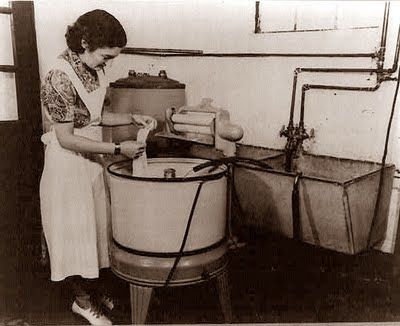Follow Erik Loomis on Twitter
Read Erik Loomis’ work at Lawyers, Guns, & Money
Historian Erik Loomis on This Day in Labor History: August 9, 1910. The first patent for the electric washing machine is issued. Let’s use this as a jumping off point to explore one of the most forgotten labor sectors in American history—unpaid domestic labor in the home!!!
Like many household technologies of the twentieth century, the washing machine created radical changes to housework, almost entirely done by women.
While Americans almost always embrace technological advances with the zeal of religious converts, in fact the larger effects of household technologies have been complex and not always great for the women engaged in domestic labor in the home.
I’m basing this argument on Ruth Schwartz Cowan’s 1983 book More Work for Mother: The Ironies of Household Technologies from the Open Hearth to the Microwave.
As Cowan points out, housework is the first form of labor humans are exposed to and through most of western history, it is the sector of work to which women have been delegated.
The key transformation was the arrival of the Industrial Revolution to the home in the late 19th century. Women always did productive labor, often unpaid, but in the earlier period that included canning, sewing, and other tasks that might bring income into the household.
Women continued to produce domestic tasks in an industrialized household, but now the consumption of that work stayed solely within the home. The labor became entirely reproductive.
Cowan shows that despite the bold promises of industrial technology entering the household, the ultimate effects were complex. New technologies were sold as freeing women from generations of the boring drudgery that was household labor.
There was a long history of trying to do this—many of the 19th century transcendental communities experimented in communal household labor precisely to free women to do more interesting things. When these went nowhere, the middle class hired people to do it for them.
Technology again promised middle-class women a life of leisure. But while new tools may have made work easier, it also meant that women had to do that work more often. The vacuum cleaner meant women cleaned their floors far more often than their mothers.
The washing machine made cleaning clothes far easier. It also raised standards of cleanliness, meaning that women had to do laundry more often.
Multiply this task by all the other tasks a woman now had to do to meet newly elevated middle-class standards of housework and you are talking a lot of work.
The washing machine itself came about as part of a larger process transforming the American home: electricity. In 1907, only 8% of American homes were wired for electricity, a number that jumped to almost 35% by 1920.
With electricity, companies began developing a wide array of new appliances to sell to the modernized home. Electric fans, sewing machines, vacuum cleaners, and washing machines flooded the market. Soon electric stoves and refrigerators would follow.
Taken together, these would revolutionize household labor. The work of women had increasingly separated from that of men in the 19th century (though more in the middle class) with the rise of the doctrine of separate spheres and the creation of the modern factory.
This would only increase with new technologies in the 20th century. It also made household workers far more productive.
One change these appliances created was a decline in hired domestic labor. Middle-class women often hired a laundress to do work. The electric machine meant the expense of hired help was not necessary.
In 1900, there was one servant for every 15 households. By 1950, that dropped to 1 for every 42. But it also meant that the middle-class woman actually did the laundry herself now, and usually several times a week.
The woman of the household did just as much work as before, but now without the help.
Add to this the movement of children away from work to schools and the rise of a youth culture, and with each passing year, women became more like the sole worker in a factory of never-ending meals, laundry, diaper-changes, vacuuming, floor washing, window washing, dusting, etc.
Technologies did not inevitably lead us down this road. Cowan also argues for the possibility of eliminating much reproductive labor through these technologies, a road not taken.
She looks at the history of commercial laundries, noting they peaked in the 1920s, when the new technologies made it possible to take that sector of work out of the home entirely. But the electric washing machine killed the commercial laundry.
Cowan argues, “The decline of the commercial laundry is, in fact, one of the few instances we have of a household function appearing to be well on its way to departing from the home—only to return.” (107).
The creation of the modern automatic machine in the late 1930s made this history.
While many at the time and today looked at washing machines as a good investment because of the cost of doing laundry, Cowan points out that only makes sense if you calculate women’s time as worth nothing.
Given the significant labor of doing laundry yourself, especially for a family, valuing your time even at the minimum wage may make commercial laundries a sensible option. Yet even today, most people either have their own laundry machines or do it themselves at laundromats.
There are somewhat legitimate critiques of this line of feminist inquiry into technology and labor.
For one, Cowan focuses too much on the middle class and ignores working-class women who not only lost their jobs as housekeepers through these technologies but had to find other employment and try to hold up to heightened middle-class standards of housework.
Cowan also downplays just how hard some of this labor was pre-technology in order to make her larger points.
I’ve read plenty of descriptions of just what doing laundry was like when you had to haul and boil water. Let’s just say that I’d embrace a new technology too.
In a related point, she ignores rural women for whom these tasks were the most onerous. But this is a relatively minor critique of a brilliant book that provides an important line of argument for thinking about household labor.
In any case, we can’t understand our labor history without discussing women’s unpaid labor in the home. Unfortunately, most of the field of labor history has ignored this since it doesn’t really fit into the Marxist precepts about work that drove the field.
But women’s unpaid labor in the home is a huge part of our labor history and our labor realities today. It needs to be recognized and analyzed. For this labor is as important as any steel mill, any strike, any revolutionary movement, any communist or anarchist group.

